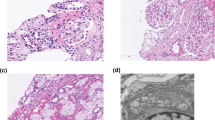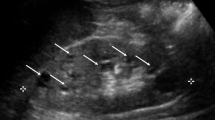Abstract
Background
Primary hyperoxaluria (PH) results from genetic mutations in different genes of glyoxylate metabolism, which cause significant increases in production of oxalate by the liver. This study aimed to report clinical and laboratory manifestations and outcome of PH type 1 in children in our center.
Methods
A single-center observational cohort study was conducted at Children’s University Hospital in Damascus, and included all patients admitted from 2018 to 2020, with a diagnosis of hyperoxaluria (urinary oxalate excretion > 45 mg/1.73 m2/day, or > 0.5 mmol/1.73 m2/day). PH type 1 (PH1) diagnosis was established by identification of biallelic pathogenic variants (compound heterozygous or homozygous mutations) in AGXT gene on molecular genetic testing.
Results
The study included 100 patients with hyperoxaluria, with slight male dominance (57%), and median age 1.75 years (range, 1 month–14 years). Initial complaint was urolithiasis or nephrocalcinosis in 47%, kidney failure manifestations in 29%, and recurrent urinary tract infection in 24%. AGXT mutations were detected in 40 patients, and 72.5% of PH1 patients had kidney failure at presentation. Neither gender, age nor urinary oxalate excretion in 24 h had statistical significance in distinguishing PH1 from other forms of hyperoxaluria (P-Value > 0.05). Parental consanguinity, family history of kidney stones, bilateral nephrocalcinosis, presence of oxalate crystals in random urine sample, kidney failure and mortality were statistically significantly higher in PH1 (P-values < 0.05). Mortality was 32.5% among PH1 patients, with 4 PH1 patients (10%) on hemodialysis awaiting combined liver–kidney transplantation.
Conclusion
PH1 is still a grave disease with wide variety of clinical presentations which frequent results in delays in diagnosis, thus kidney failure is still a common presentation. In Syria, we face many challenges in diagnosis of PH, especially PH2 and PH3, and in management, with hopes that diagnosis tools and modern therapies will become available in our country.

A higher resolution version of the Graphical abstract is available as Supplementary information.
Similar content being viewed by others
References
Alon US, Srivastava T (2017) Urolithiasis in children. In: Kher KK, Schnaper HW, Greenbaum LA (eds) Clinical Pediatric Nephrology, 3rd edn. Boca Raton, pp 1014–1015
Demoulin N, Aydin S, Gillion V, Morelle J, Jadoul M (2022) Pathophysiology and management of hyperoxaluria and oxalate nephropathy: a review. Am J Kidney Dis 79:717–727. https://doi.org/10.1053/j.ajkd.2021.07.018
Danpure CJ (2006) Primary hyperoxaluria type 1: AGT mistargeting highlights the fundamental differences between the peroxisomal and mitochondrial protein import pathways. Biochim Biophys Acta 1763:1776–1784
Harambat J, Fargue S, Bacchetta J, Acquaviva C, Cochat P (2011) Primary hyperoxaluria. Int J Nephrol 2011:864580. https://doi.org/10.4061/2011/864580
Milliner DS, Harris PC, Sas DJ, Cogal AG, Lieske JC (2002) Primary Hyperoxaluria Type 1. In: Adam MP, Everman DB, Mirzaa GM, Pagon RA, Wallace SE, Bean LJH, Gripp KW, Amemiya A (eds). GeneReviews® [Internet]. University of Washington, Seattle, Seattle, 1993–2022
Weigert A, Martin-Higueras C, Hoppe B (2018) Novel therapeutic approaches in primary hyperoxaluria. Expert Opin Emerg Drugs 23:349–357. https://doi.org/10.1080/14728214.2018.1552940
Garrelfs SF, Rumsby G, Peters-Sengers H, Erger F, Groothoff JW, Beck BB, Oosterveld MJS, Pelle A, Neuhaus T, Adams B, Cochat P, Salido E, Lipkin GW, Hoppe B, Hulton SA, OxalEurope Consortium (2019) Patients with primary hyperoxaluria type 2 have significant morbidity and require careful follow-up. Kidney Int 96:1389–1399. https://doi.org/10.1016/j.kint.2019.08.018
Martin-Higueras C, Garrelfs SF, Groothoff JW, Jacob DE, Moochhala SH, Bacchetta J, Acquaviva C, Zaniew M, Sikora P, Beck BB, Hoppe B (2021) A report from the European Hyperoxaluria Consortium (OxalEurope) Registry on a large cohort of patients with primary hyperoxaluria type 3. Kidney Int 100:621–635. https://doi.org/10.1016/j.kint.2021.03.031
Hoppe B (2012) An update on primary hyperoxaluria. Nat Rev Nephrol 8:467–475. https://doi.org/10.1038/nrneph.2012.113
Hoppe B, Martin-Higueras C (2022) Improving Treatment Options for Primary Hyperoxaluria. Drugs 82:1077–1094. https://doi.org/10.1007/s40265-022-01735-x
Cochat P, Rumsby G (2013) Primary hyperoxaluria. N Engl J Med 369:649–658. https://doi.org/10.1056/NEJMra1301564
Beck BB, Hoyer-Kuhn H, Göbel H, Habbig S, Hoppe B (2013) Hyperoxaluria and systemic oxalosis: an update on current therapy and future directions. Expert Opin Investig Drugs 22:117–129. https://doi.org/10.1517/13543784.2013.741587
Devresse A, Cochat P, Godefroid N, Kanaan N (2020) Transplantation for primary hyperoxaluria type 1: designing new strategies in the era of promising therapeutic perspectives. Kidney Int Rep 5:2136–2145. https://doi.org/10.1016/j.ekir.2020.09.022
Metry EL, Garrelfs SF, Peters-Sengers H, Hulton SA, Acquaviva C, Bacchetta J, Beck BB, Collard L, Deschênes G, Franssen C, Kemper MJ, Lipkin GW, Mandrile G, Mohebbi N, Moochhala SH, Oosterveld MJS, Prikhodina L, Hoppe B, Cochat P, Groothoff JW, OxalEurope Consortium (2021) Long-term transplantation outcomes in patients with primary hyperoxaluria type 1 included in the European Hyperoxaluria Consortium (OxalEurope) registry. Kidney Int Rep 7:210–220. https://doi.org/10.1016/j.ekir.2021.11.006
Garrelfs SF, Frishberg Y, Hulton SA, Koren MJ, O’Riordan WD, Cochat P, Deschênes G, Shasha-Lavsky H, Saland JM, van’t Hoff WG, Fuster DG, Magen D, Moochhala SH, Schalk G, Simkova E, Groothoff JW, Sas DJ, Meliambro KA, Lu J, Sweetser MT, Garg PP, Vaishnaw AK, Gansner JM, McGregor TL, Lieske JC; ILLUMINATE-A Collaborators (2021) Lumasiran, an RNAi therapeutic for primary hyperoxaluria type 1. N Engl J Med 384:1216–1226. https://doi.org/10.1056/NEJMoa2021712
Hoppe B, Koch A, Cochat P, Garrelfs SF, Baum MA, Groothoff JW, Lipkin G, Coenen M, Schalk G, Amrite A, McDougall D, Barrios K, Langman CB (2022) Safety, pharmacodynamics, and exposure-response modeling results from a first-in-human phase 1 study of nedosiran (PHYOX1) in primary hyperoxaluria. Kidney Int 101:626–634. https://doi.org/10.1016/j.kint.2021.08.015
Scott LJ, Keam SJ (2021) Lumasiran: first approval. Drugs 81:277–282. https://doi.org/10.1007/s40265-020-01463-0
Shee K, Stoller ML (2022) Perspectives in primary hyperoxaluria - historical, current and future clinical interventions. Nat Rev Urol 19:137–146. https://doi.org/10.1038/s41585-021-00543-4
Rhuma NR, Fituri OA, Sabei LT (2018) Mutational analysis of AGXT gene in Libyan children with primary hyperoxaluria type 1 at Tripoli Children Hospital. Saudi J Kidney Dis Transpl 29:30–38. https://doi.org/10.4103/1319-2442.225202
Nagara M, Tiar A, Ben Halim N, Ben Rhouma F, Messaoud O, Bouyacoub Y, Kefi R, Hassayoun S, Zouari N, Ben Ammar MS, Abdelhak S, Chemli J (2013) Mutation spectrum of primary hyperoxaluria type 1 in Tunisia: implication for diagnosis in North Africa. Gene 527:316–320. https://doi.org/10.1016/j.gene.2013.06.023
Guillaume A, Chiodini B, Adams B, Dahan K, Deschênes G, Ismaili K (2021) The struggling odyssey of infantile primary hyperoxaluria. Front Pediatr 9:615183. https://doi.org/10.3389/fped.2021.615183
Soliman NA, Elmonem MA, Abdelrahman SM, Nabhan MM, Fahmy YA, Cogal A, Harris PC, Milliner DS (2022) Clinical and molecular characterization of primary hyperoxaluria in Egypt. Sci Rep 12:15886. https://doi.org/10.1038/s41598-022-17980-9
Al Riyami MS, Al Ghaithi B, Al Hashmi N, Al Kalbani N (2015) Primary hyperoxaluria type 1 in 18 children: genotyping and outcome. Int J Nephrol 2015:634175. https://doi.org/10.1155/2015/634175
Fadel FI, Kotb MA, Abdel Mawla MA, Hasanin RM, Salem AM, Fathallah MG, Amr KS, Ahmed HA, Salah DM (2022) Primary hyperoxaluria type 1 in children: clinical classification, renal replacement therapy, and outcome in a single centre experience. Ther Apher Dial 26:162–170. https://doi.org/10.1111/1744-9987.13666
Hopp K, Cogal AG, Bergstralh EJ, Seide BM, Olson JB, Meek AM, Lieske JC, Milliner DS, Harris PC, Rare Kidney Stone Consortium (2015) Phenotype-genotype correlations and estimated carrier frequencies of primary hyperoxaluria. J Am Soc Nephrol 26:2559–2570. https://doi.org/10.1681/ASN.2014070698
Harambat J, van Stralen KJ, Espinosa L, Groothoff JW, Hulton SA, Cerkauskiene R, Schaefer F, Verrina E, Jager KJ, Cochat P, European Society for Pediatric Nephrology/European Renal Association-European Dialysis and Transplant Association (ESPN/ERA-EDTA) Registry (2012) Characteristics and outcomes of children with primary oxalosis requiring renal replacement therapy. Clin J Am Soc Nephrol 7:458–465. https://doi.org/10.2215/CJN.07430711
Bergstralh EJ, Monico CG, Lieske JC, Herges RM, Langman CB, Hoppe B, Milliner DS; IPHR Investigators (2010) Transplantation outcomes in primary hyperoxaluria. Am J Transplant 10:2493–2501. https://doi.org/10.1111/j.1600-6143.2010.03271.x
Bunchman TE, Swartz RD (1994) Oxalate removal in type I hyperoxaluria or acquired oxalosis using HD and equilibration PD. Perit Dial Int 14:81–84
Illies F, Bonzel KE, Wingen AM, Latta K, Hoyer PF (2006) Clearance and removal of oxalate in children on intensified dialysis for primary hyperoxaluria type 1. Kidney Int 70:1642–1648. https://doi.org/10.1038/sj.ki.5001806
Hoppe B, Graf D, Offner G, Latta K, Byrd DJ, Michalk D, Brodehl J (1996) Oxalate elimination via hemodialysis or peritoneal dialysis in children with chronic renal failure. Pediatr Nephrol 10:488–492. https://doi.org/10.1007/s004670050145
Acknowledgements
I would like to express my sincere gratitude to Dr. Hossam Murad, who performed the genetic analysis to our patients at Human Genetics Division, Molecular Biology and Biotechnology Department, Atomic Energy Commission of Syria.
Author information
Authors and Affiliations
Corresponding author
Ethics declarations
Consent to participate
Informed consent was obtained from all individual participants included in the study.
Competing interests
The author has no relevant financial or non-financial interests to disclose.
Conflict of interest
No conflict of interest.
Additional information
Publisher's note
Springer Nature remains neutral with regard to jurisdictional claims in published maps and institutional affiliations.
Supplementary Information
Below is the link to the electronic supplementary material.
Rights and permissions
Springer Nature or its licensor (e.g. a society or other partner) holds exclusive rights to this article under a publishing agreement with the author(s) or other rightsholder(s); author self-archiving of the accepted manuscript version of this article is solely governed by the terms of such publishing agreement and applicable law.
About this article
Cite this article
Wannous, H. Primary hyperoxaluria type 1 in children: clinical and laboratory manifestations and outcome. Pediatr Nephrol 38, 2643–2648 (2023). https://doi.org/10.1007/s00467-023-05917-x
Received:
Revised:
Accepted:
Published:
Issue Date:
DOI: https://doi.org/10.1007/s00467-023-05917-x




